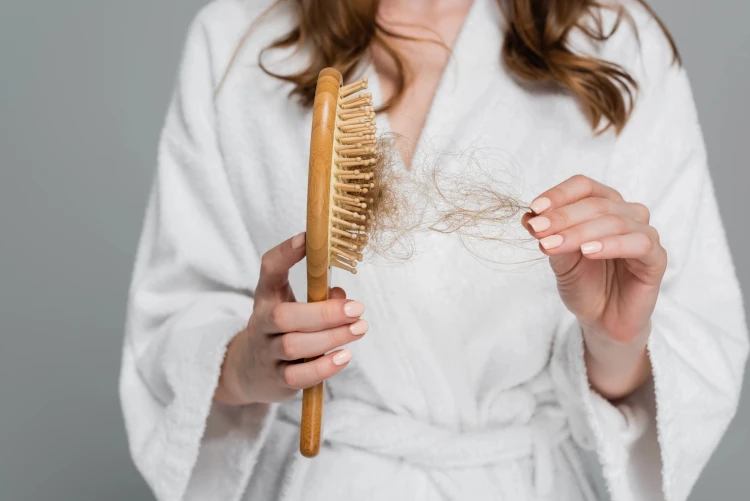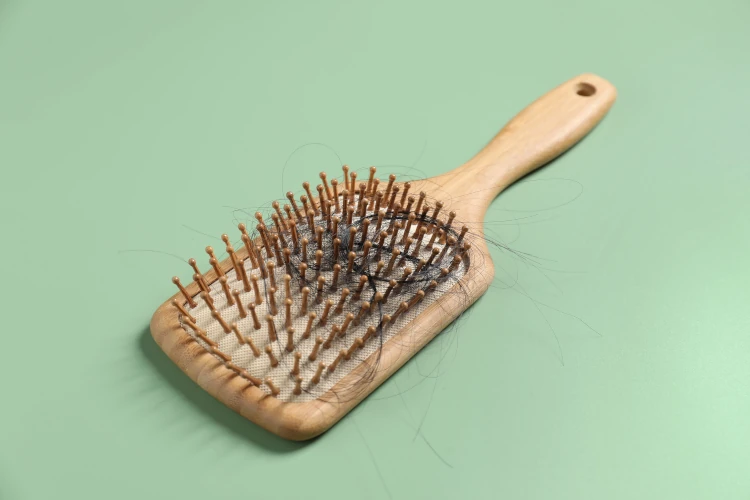
How Many Hairs Do You Lose Per Day on Average?
You probably notice a few strands of hair on your brush or pillow each day, and it’s easy to worry. But losing some hair daily is completely normal. In fact, it’s a natural part of the hair growth cycle and doesn’t automatically mean you’re experiencing hair loss.
Most people lose about 50 to 100 hairs every day, on average. That number may sound high, but considering the average scalp contains around 100,000 hairs, this small amount doesn’t usually make a noticeable difference.
In this article, you’ll learn how many hairs you lose per day, what influences that number, how to tell the difference between normal shedding and hair loss, and what steps you can take if you think the shedding is excessive.
What Affects How Many Pieces of Hair You Lose a Day?
Several everyday factors can increase or decrease the number of hairs you shed. Stress, both emotional and physical, is one of the most common culprits. When you’re overwhelmed or recovering from an illness, your body may shift more hair into the shedding phase of the growth cycle.
Hormonal changes also have a major impact. Pregnancy, menopause, and thyroid imbalances can all affect how much hair you lose. In addition, if you struggle with scalp issues like dandruff, this can make things worse.
Conditions like seborrheic dermatitis often cause inflammation that disrupts healthy follicle function, contributing to shedding. Further, the link between dandruff and hair loss demonstrates how inflammation and irritation can contribute to excess shedding, while also disrupting follicle health.
Poor nutrition can be another root cause. When your body lacks iron, protein, or certain vitamins, you may notice increased shedding. A known cause for thinning hair is inadequate intake of essential nutrients that support follicle strength.
Your daily habits also play a role. Using heat tools too frequently or brushing aggressively can lead to breakage and loss. Tight hairstyles, chemical treatments, and even sleeping on rough pillowcases may weaken the strands over time. Even seemingly harmless behaviors, like tying your hair up when wet, can lead to additional tension on the roots, compounding the issue. Environmental factors, such as extreme sun exposure or hard water, may also damage your scalp and contribute to a higher rate of shedding.
Role of the Hair Growth Cycle in Daily Shedding

To truly understand why some hair falls out each day, it helps to know how the hair growth cycle works. Hair grows in stages:
- Anagen phase: This is the active growing phase, which can last 3 to 6 years.
- Catagen phase: A brief phase where growth slows, lasting about 2 to 3 weeks.
- Telogen phase: During this phase, hair stops growing and begins to shed. It typically lasts around 2 to 3 months.
Hair naturally falls out during the telogen phase to make room for new strands. So, if you notice some hair in the drain or on your pillowcase, it could just be the cycle doing its job.
Hair Loss vs. Natural Shedding
There’s a clear difference between normal shedding and actual hair loss. Again, most people fall within the average range of 50 to 100 hairs a day. However, what’s normal for one person might not be for another.
Pay attention to any changes in your hair. If your shedding seems consistent and you’re not noticing any patches or thinning areas, chances are you’re experiencing regular hair turnover. But if the amount increases noticeably or your ponytail feels thinner, it might be time to take a closer look.
Start tracking your hair habits. Keep an eye on how much hair you see in your brush or shower drain. Small changes are natural, but sustained increases may be worth discussing with a specialist.
When Is Daily Hair Loss Considered Abnormal?
A noticeable increase in daily shedding — especially if you’re finding clumps of hair on your pillow, clothing, or in the shower — could be a sign that something more serious is going on. The amount of hair you lose in the shower varies from person to person, but recognizing your personal baseline and comparing it with insights like how much hair is normal to lose in the shower can help you assess whether the shedding is within a healthy range.
Other visible changes, such as thinning along your part, a more visible scalp, or developing small bald spots, can signal a disruption in your hair’s natural growth cycle. These signs are sometimes tied to underlying health conditions, including alopecia areata, chronic scalp inflammation, or fungal infections.
If these patterns continue for several weeks, seeking guidance from a dermatologist or trichologist is a smart next step. They can help pinpoint whether the issue is stress-related, hormonal, or tied to a specific medical condition, and recommend a course of action before the problem progresses.
What To Do if You Think You’re Losing Too Much Hair
When your hair seems to be falling out faster than usual, there are steps you can take to minimize the damage and support healthy regrowth. Start with your products. Choose gentle, sulfate-free shampoos, which help preserve your scalp’s natural oils and reduce irritation. Incorporate a conditioner that hydrates without weighing your hair down.
Your diet matters, too. Eating a balanced mix of protein, iron, and vitamins A, D, and E can strengthen your strands from the inside out. Focus on whole foods like leafy greens, eggs, nuts, and lean meats. Cut back on damaging habits like daily heat styling and tight hairstyles. Give your hair time to recover by air-drying more often and using protective styles.
If no improvement is seen after three to six months of conservative changes, a professional evaluation may be needed, along with possible diagnostic tests, such as ferritin, thyroid, and hormone level checks. Upon evaluation, if you’re still experiencing advanced shedding or you’re dealing with visible thinning, it might be time to consider hair restoration treatments that support regrowth through medically guided approaches.
Realistic outcomes are visible through before-and-after hair transplant documentation, which reflects the effectiveness of certain procedures when appropriate. Understanding the cost of a hair transplant is also important when considering this option. Prices vary depending on the technique used and the extent of the treatment needed.
Ultimately, shedding some hair each day is completely normal. What matters most is recognizing when something changes and knowing how to respond in a way that supports your hair’s health in the long run.


